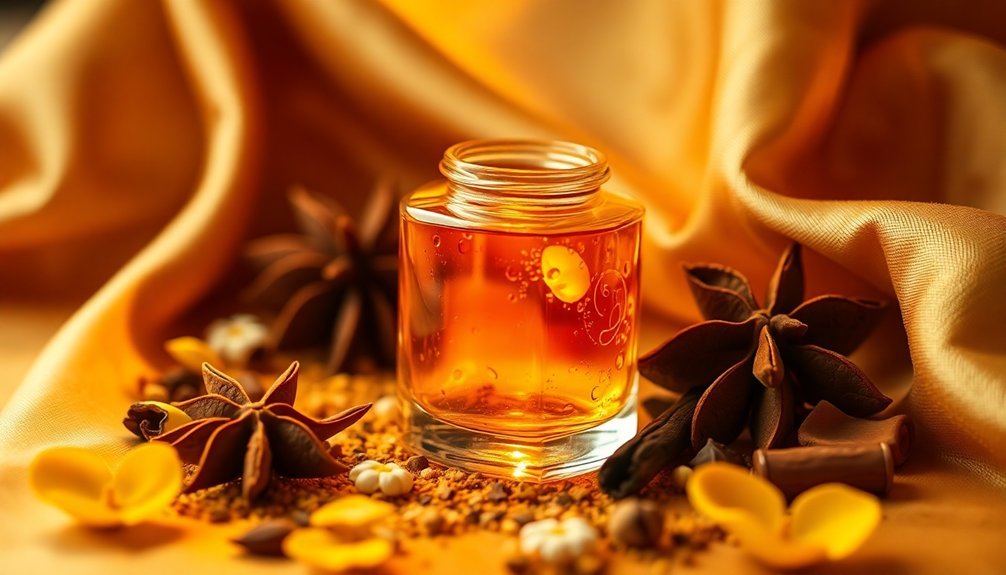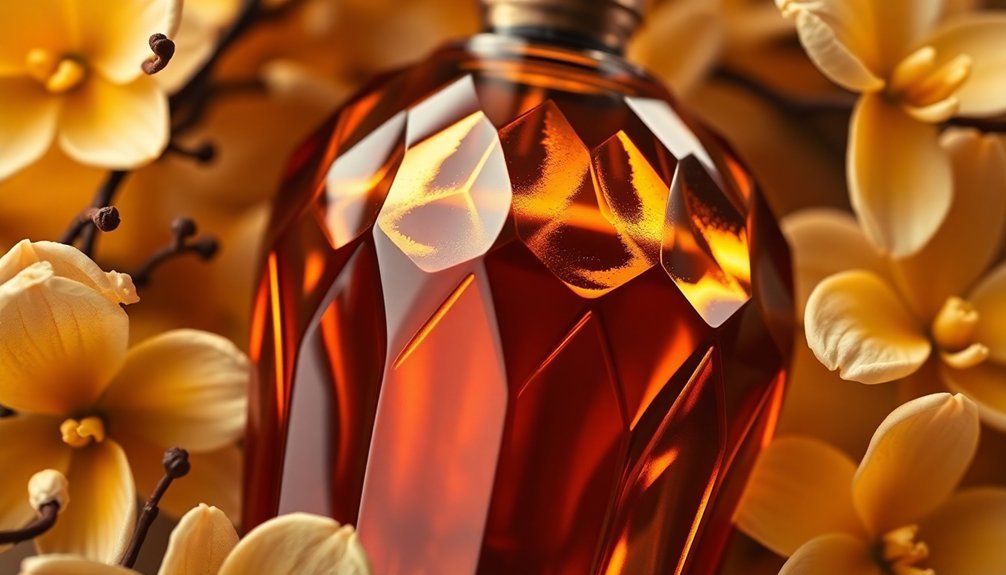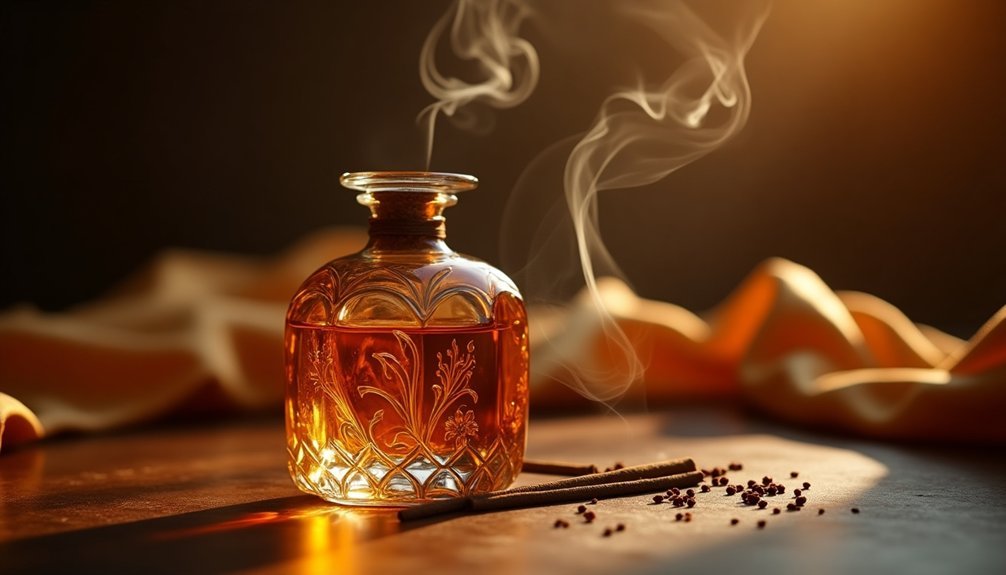Oriental amber bases blend rich, sweet raw materials like vanilla and tonka bean with sophisticated resins including benzoin, myrrh, and frankincense. You'll find labdanum and patchouli creating a warm, sensual backdrop while precise ratios of these ingredients establish the signature warmth and depth that's made these fragrances timeless. Today's perfumers combine these traditional elements with innovative accords, offering both classic luxury and unexpected twists in modern interpretations.
The Core Elements of Oriental Amber Bases

When perfumers create oriental amber bases, they rely on a harmonious blend of rich, sweet raw materials that form the foundation of these enchanting fragrances.
You'll find vanilla and tonka bean at the heart of these compositions, providing creamy sweetness and nutty depth that define the amber character.
The complex interplay of resins, including benzoin, myrrh, and frankincense, adds sophisticated layers to these fragrances.
You'll notice how labdanum and patchouli work together to create a warm, sensual backdrop that's both inviting and mysterious.
These carefully balanced ingredients can produce varying effects in the final fragrance, from soft and comforting to deep and intense.
Whether you prefer a subtle amber whisper or a bold oriental statement, these core elements work together to create the signature warmth that makes amber bases so enchanting.
Traditional Raw Materials and Their Synergies
The ancient craft of resin extraction from cistus ladanifer plants reveals the time-honored methods that still influence today's amber base production.
You'll find that vanilla and tonka bean create a noble harmony, with vanilla's sweet depth perfectly complementing tonka's hay-like coumarin notes.
These raw materials work together to form the backbone of oriental amber compositions, where their individual characteristics merge into a seamless, luxurious whole.
Ancient Resin Extraction Methods
Throughout history, master perfumers have relied on time-tested extraction methods to capture the essence of precious resins for oriental amber fragrances. You'll find these ancient resin extraction methods still influence modern perfumery, from the traditional tincturing process to dry distillation techniques.
| Resin Type | Extraction Method | Key Characteristics |
|---|---|---|
| Labdanum | Goat Hair Scraping | Rich, Complex Profile |
| Benzoin | Bark Incision | Warm, Sweet Notes |
| Myrrh | Tree Scoring | Oleo-gum-resin Tears |
| Frankincense | Bark Tapping | Spicy, Balsamic |
Each method has been perfected over centuries to preserve the resin's unique properties. You'll discover that whether it's the painstaking collection of labdanum from goat fur or the careful scoring of Commiphora bark for myrrh, these extraction techniques remain essential to creating authentic amber fragrances.
Noble Vanilla Tonka Harmonies
Noble vanilla and tonka bean form a revered partnership in oriental amber perfumery, creating sophisticated harmonies that elevate fragrance compositions.
You'll find that vanilla's rich sweetness, derived from the vanilla planifolia orchid, blends seamlessly with tonka bean's warm, complex profile. While vanilla contributes its signature vanillin and ethylvanillin compounds, tonka bean's coumarin adds enticing notes of sweet hay and almond.
Together, they create a luxurious, creamy foundation that's essential to the classic oriental accord.
When you experience this synergistic blend in perfumes, you'll notice how these traditional raw materials complement each other perfectly. They work alongside other oriental ingredients like benzoin and labdanum, delivering a deep, sensual fragrance that wraps you in warmth and comfort.
Balancing Sweet and Resinous Notes

Creating a harmonious oriental amber fragrance requires mastering the delicate interplay between sweet and resinous components. When you're crafting amber perfumes, you'll find that vanilla and tonka bean provide the essential sweet foundation, while labdanum and benzoin contribute deeper, resinous dimensions.
Balancing sweet and resinous notes is vital for achieving the signature warmth that makes oriental fragrances so enchanting. You'll notice how vanilla's creamy sweetness melds perfectly with tonka bean's nutty richness, while the balsamic, smoky qualities of labdanum and benzoin add complexity and depth.
Essential Amber Accords and Ratios
When developing an oriental amber base, understanding the precise ratios of key ingredients is essential for achieving the signature warmth and depth that define these fragrances. The amber notes you'll create will depend heavily on the proportions of sweet and resinous elements in your composition.
| Component | Concentration | Key Contribution |
|---|---|---|
| Vanilla/Tonka | 30-40% | Sweet, creamy base |
| Labdanum | 10-20% | Dark, spicy depth |
| Benzoin | 5-15% | Balsamic sweetness |
| Patchouli/Spices | 5-10% | Earthy complexity |
You'll want to start with higher concentrations of vanilla and tonka bean to establish the sweet foundation, then layer in labdanum for its rich, spicy character. Benzoin's balsamic qualities will help bind these elements together, creating that luxurious, enveloping amber accord that's characteristic of oriental fragrances.
Crafting Depth With Vanilla and Tonka Bean

The rich interplay between vanilla and tonka bean forms the backbone of any sophisticated oriental amber base.
When you're crafting an oriental fragrance, you'll find vanilla bean's sweet warmth enhances the overall sensuality of your composition. The tonka bean's complex profile, driven by coumarin, adds nutty and spicy dimensions that perfectly complement vanilla's richness.
These two ingredients work together to create layers of depth you won't achieve with either note alone.
You'll notice how the vanilla provides a smooth, creamy foundation while the tonka bean introduces subtle complexity.
It's no wonder these components have become essential in modern perfumery – they're versatile enough to appeal to diverse preferences while maintaining the luxurious character that defines oriental fragrances.
Resinous Foundations: Labdanum and Benzoin
You'll find fascinating contrasts between the ancient collection of labdanum, where shepherds once used wooden combs to gather resin from goats' fur, and today's sophisticated solvent extraction methods.
Modern techniques now allow for precise isolation of these precious aromatic compounds, resulting in purer and more concentrated forms of both labdanum and benzoin.
The evolution from traditional harvesting to current extraction processes shows how perfumery has maintained its connection to historical practices while embracing technological advances.
Ancient Harvesting Methods
Ancient harvesters mastered ingenious techniques to collect prized fragrance resins, particularly labdanum and benzoin.
You'll find it fascinating that goats played a significant role in labdanum collection, as they'd graze on cistus ladanifer plants, helping release the sticky raw materials that would later form the backbone of amber fragrances.
The collection of benzoin followed a different path, requiring skilled harvesters to tap the Styrax tree's bark through careful incisions.
Once exposed to air, the resin would slowly ooze out and harden, creating the precious substance that's been treasured across cultures for centuries.
These time-honored harvesting methods demonstrate how deeply intertwined natural processes and human ingenuity were in creating the luxurious oriental fragrances we recognize today.
Modern Extraction Techniques
Modern extraction of labdanum and benzoin has evolved dramatically from traditional harvesting methods, incorporating advanced technologies that maximize both efficiency and quality.
You'll find that today's oriental amber base notes benefit from sophisticated extraction processes like solvent extraction, steam distillation, and supercritical CO2 techniques.
When you compare modern extraction techniques to ancient methods, you'll notice significant improvements in yield and aromatic preservation.
Labdanum's toffee-like essence is now carefully extracted from cistus ladanifer, while benzoin's vanilla-sweet properties are drawn from Styrax bark using precision-based processes.
These advanced methods guarantee you're getting the purest form of these resins, which are essential for creating the warm, complex characteristics that define amber fragrances.
CO2 extraction particularly stands out for its ability to capture desired compounds without harsh solvents.
Modern Interpretations of Classic Oriental Bases

Over the past decade, traditional oriental amber bases have undergone a remarkable transformation as perfumers blend time-honored ingredients with innovative accords.
You'll find modern olfactory experiences that combine classic vanilla, tonka bean, and patchouli with unexpected elements like fruity or aquatic notes.
Leading perfume houses like Goutal and Clive Christian are redefining amber fragrances through innovative ingredients while preserving their rich, warm character.
They're embracing synthetic versions of ambergris and labdanum to guarantee consistency and release creative possibilities.
You'll discover unique compositions where sweet resins and spices meet fresh florals and crisp citrus, creating multifaceted scent profiles.
This evolution reflects a growing commitment to sustainability, as perfumers source ingredients with environmental consciousness in mind, delivering luxurious yet responsible fragrance experiences.
Frequently Asked Questions
What Does Oriental Amber Smell Like?
You'll experience a warm, rich fragrance that's sweet and resinous, with deep notes of vanilla, tonka bean, and patchouli. It wraps you in honeyed warmth while exotic spices and resins linger harmoniously.
What Is the Most Seductive Scent for a Woman?
You'll find the most seductive scents often feature oriental amber notes like vanilla and patchouli. These warm, sensual fragrances blend with your natural chemistry to create an alluring, confident aura that lingers.
What Is Amber Fragrance Notes?
You'll find amber notes are warm, sweet, and resinous combinations of labdanum, benzoin, and vanilla. They're complex scents that evolve from inviting top notes to deep, lasting base notes that comfort you.
Is Amber a Seductive Scent?
Yes, you'll find amber is highly seductive. Its warm, sweet notes create an intimate atmosphere, while its rich, lingering presence on your skin naturally draws others closer with its sensual and inviting qualities.
In Summary
You'll find that mastering oriental amber bases comes down to carefully balancing sweet and resinous elements while honoring traditional materials. Whether you're working with classic labdanum-vanilla accords or exploring modern interpretations, the key lies in maintaining harmony between the warm, rich components. Trust your nose and don't be afraid to experiment, but always respect the time-tested foundations that make these bases eternally enchanting.





Leave a Reply